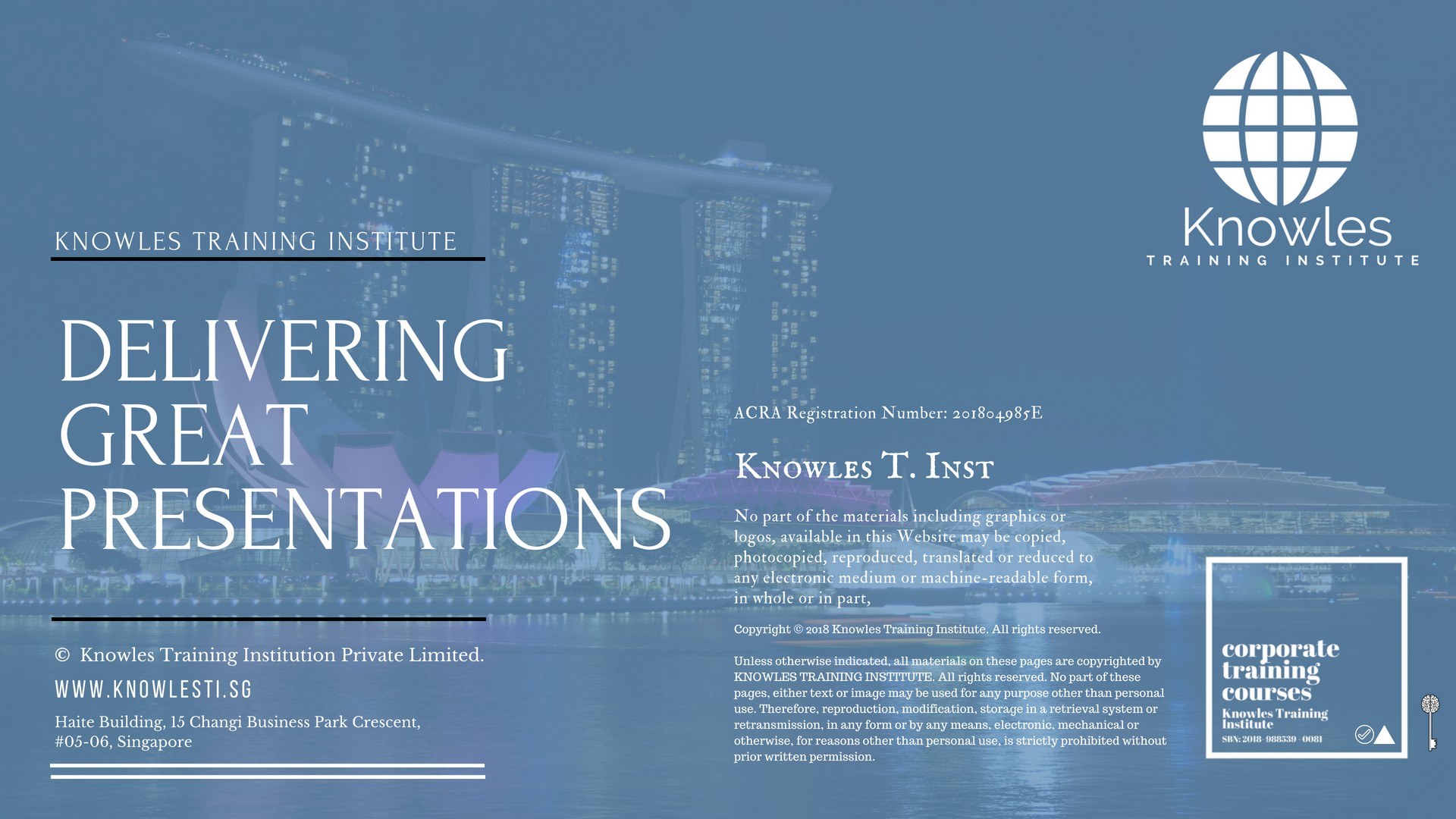This Presentation Skills Training Course
is also available in Jerusalem, Tel Aviv, Haifa, Petah Tiqwa, Ashdod, Netanya, Rishon LeZiyyon, Bnei Brak, Holon, and Beersheba.

About This Presentation Skills Training Course in Israel
Presentation Skills Training Course in Israel
To deliver an excellent presentation, you don’t have to raise your voice or perform tricks to keep your audience engaged. Many studies have found that public speaking is the number one fear amongst most people, outranking flying, snakes, insects, and even death. It is also one of the skills that can make or break a person’s career.
In this presentation skills course, training participants will effective presentation skills that will make them highly competent.
Who Should Attend This Presentation Skills Course in Israel
This Presentations skills training Training Course in Israel workshop is ideal for anyone who would like to gain a strong grasp and improve their Delivering Great Presentations.
- All Staff Within An Organisation
- Managers
Team Leaders
Executives
Assistants
Officers
Secretaries
Group Size For This Presentation Skills Course in Israel
The ideal group size for this Delivering Great Presentations course in Israel is:
Minimum: 5 Participants
Minimum: 15 Participants
Course Duration For This Presentation Skills Course in Israel
The duration of this Presentations training course in Israel workshop is 2 full days. Knowles Training Institute Israel will also be able to contextualised this workshop according to different durations; 3 full days, 1 day, half day, 90 minutes and 60 minutes.
2 Full Days
9 a.m to 5 p.m
Presentations Training Course in Israel Objectives
Below Is The List Of Course Objectives Of Our Delivering Great Presentations Course in Israel
Presentation Skills Course in Israel Training – Part 1
- Perform A Needs Analysis And Prepare An Outline For Your Presentation.
- Select Presentation Delivery Methods.
Presentation Skills Course in Israel Training – Part 2
- Practice Verbal And Non-Verbal Communication Skills.
- Elimiate Nervousness Before and During Presentations.
Presentation Skills Course in Israel Training – Part 3
- Develop And Use Flip Charts With Colour.
- Create Targeted Powerpoint Presentations.
Presentation Skills Course in Israel Training – Part 4
- Utilise White Board For Reinforcement.
- Explain How Video And Audio Enhance A Presentation.
- Enrich The Learning Experience With Humour, Questions, And Discussion During Your Presentation.
Course Content For This Delivering Great Presentations Training Course in Israel
Below Is The List Of Course Content Of Our Delivering Great Presentations Course in Israel
Presentation Skills Course in Israel – Part 1: Creating The Program For Your Presentation
In the first part of this presentation skills course, we will look at the steps to follow when designing a plan to enhance your presentation skills. The first thing you need to do is to conduct a needs analysis. This will assist you to understand better the audience you are presenting to and provide you with the solutions to a few common basic questions. A basic framework and some minor study would then be utilized to help create a basic program that will help you in developing your presentation skills.
- How To Perform a Needs Analysis For Your Presentation
- A needs analysis measures what kind of different skills employees have and what skills they would need. It can show you how to deliver the training at the appropriate time.
- Writing the Basic Outline of Your Presentation
- To develop the outline for your presentation, consolidate the tasks that fit together and create headings that reflect the goal of the subtasks.
- Researching, Writing, and Editing Your Presentation
Presentation Skills Course in Israel – Part 2: Choosing Your Presentation Delivery Methods
In this section of the presentation course, you will determine what methods you will use to deliver your presentation. We will be beginning by covering basic presentation delivery techniques. Once we have a strong foundation and grasp on the basic techniques, we will then dive into more advanced presentation methods.
- Basic Presentation Delivery Methods
- Advanced Presentation Delivery Methods
- After you feel satisfied with basic delivery techniques, you can then begin to explore some challenging ways to present and facilitate learning experiences.
- Basic Criteria to Consider
- A training presentation can be a combination of different delivery methods as long as the net result is to achieve learning outcomes.
Presentation Skills Course in Israel – Part 3: Verbal Communication Skills During Presentations
Communication skills are required in order to deliver a great presentation. Without being able to verbalize your ideas and opinions, there is very little chance of having a successful presentation. This part of the presentation course will begin with looking, listening, and hearing skills, asking the proper and helpful questions, and finish off communicating with increased power.
- Listening and Hearing: They Aren’t the Same Thing
- Hearing is an act of perceiving sound by the ear. Assuming an individual is not hearing-impaired, hearing is something that naturally happens. Listening, however, is something that one has to choose to do. Listening requires attention so that the brain can process information from words and sentences. Listening leads to learning.
- Asking Questions
- Types of questions are helpful in a presentation; open-ended questions, clarifying questions, and closed questions.
- How to Communicate with Power
- It’s been said that you have exactly thirty seconds and two minutes to capture your everyone’s’ attention. It is crucial to be able to engage people from the beginning
Presentation Skills Course in Israel – Part 4: Non-Verbal Communication Skills During Presentations
- Appropriate Body Language for Presentation
- Non-verbal communication is a method of communication by sending and receiving messages that contain no words. It is the most important form of communication. Nonverbal communication cues you into what is on another person’s mind, even more than voice or words can do.
- Gestures to Use During Presentation
- Gestures are an essential tool for any presenter. The challenge is to make gestures to support the speaking, reinforcing ideas.
- The Signals You Send to Others
- Signals are movements used to communicate your needs, desires, and feelings to other people. They are a form of expressive communication. More than 75% of the signs and signals you send to others are non-verbal.
- It’s Not What You Say; It’s How You Say It
Presentation Skills Course in Israel – Part 5: Overcoming Nervousness Before and During Presentation
Nervousness is perfectly normal when delivering a presentation. Public speaking is one of the top fear in the top ten lists of fears. Nervousness can strike at any point in a presentation. In the beginning, if you feel the audience has slipped away from you and if your memory betrays you. This part of the presentation course will provide you with methods to overcome presentation jitters.
- Preparing Mentally
- Visualization is the formation of visual images – mentally. It is a great way to prepare your mind before delivering a presentation.
- Physical Relaxation Techniques
- When nervous, people tend to breathe many short, shallow breaths in their upper chest.
- Appearing Confident in Front of the Crowd
Presentation Skills Course in Israel – Part 6: Creating Fantastic Flip Charts For Your Presentation
- Required Tools
- You might need a flip chart easel, pads of flip chart paper, a few sets of colored markers, and masking tape to showcase the results of exercises.
- The Advantages of Pre-Writing
- There are many great reasons to pre-write your flip chart content
- Using Colors Appropriately
- Good use of different bright colors can make a difference in the dynamics of a presentation — and how participants view the content. Also, the effect of a great chart can suffer from the lack of color.
- Creating a Plan B
- Paper isn’t permanent. If you’re traveling with your materials or shipping them, such packages can get lost and/or damaged. You will need a plan B in case something happens
Presentation Skills Course in Israel– Part 7: Creating Compelling PowerPoint Presentations
Microsoft PowerPoint is a great tool to use when creating slides (visually) for a presentation. Visuals that are created in PowerPoint and shown on a screen is easier to see in a larger room than information displayed on a flip chart.
- List of Required Tools
- Beautiful Powerpoint Presentation: Tips and Tricks
- Creating a Plan B
- Though technology enables you to make great improvements to a presentation, it also offers many more opportunities for technical difficulties. Here are suggestions to keep your presentation moving along, even if the technology isn’t.
Presentation Skills Course in Israel – Part 8: Wow ‘Em with the Whiteboard
A whiteboard is a name for any gloss-surfaced writing board where non-permanent writings can be done. Unlike its predecessor, the chalkboard, there is no chalk dust, and markings remain longer than they would on a chalkboard. Whiteboards have been around since the 1970s, and are now improved and significantly more affordable compared to early models. The use of a whiteboard helps to improve interactivity during a presentation.
- Traditional and Electronic Whiteboards
- Using Colors Appropriately
- Colors on a whiteboard are often more vivid than those on a flip chart.
- Creating a Plan B
Presentation Skills Course in Israel – Part 9: Vibrant Videos and Amazing Audio
Audio and video are a part of our everyday lives, so they are accepted –and even media in a presentation. They are appealing options for a presentation because they provide learners with more dimensions by which to receive information. While video and audio both represent a one-way communication to participants, the opportunity to use them as part of learning exercises or in the ensuing discussions adds value to the presentation
- Required Tools For Audio & Video
- For video with audio, you will need some type of player, depending upon the media type
- Tips and Tricks For Audio & Video
- Creating a Plan B For Your Audio & Video
- Regardless of the method you use for your audio and video, it is essential to have a plan B set in place in the event that something goes awry with the technology.
Presentation Skills Course in Israel – Part 10: Pumping Up Your Presentation Up a Notch
Bringing it to the next level is something you can accomplish after feeling comfortable with all of the previous topics discussed. You can add the little touches that will produce a lot of value during your presentation.
- Make Them Laugh a Little
- Humor is one the most popular way to hype a presentation. It makes the audience get align with you, and it also sends a signal that you are in charge. If delivered well, humor enriches a presentation.
- Questioning Techniques
- Proper questions can also be used in many ways, and at just about any time during your presentation.
- Encouraging Discussion
- Most of the discussion during your presentation should be structured to fit with the learning exercises. If a comment or question is made during a discussion that is not of the topic or something that will not be appropriate to deal with at that time, you can always add it to the parking lot, and come back to it during the wrap-up to bring closure.
- Dealing with Questions
- If time permits in your presentation, you should wish to hold a general question-and-answer session.


